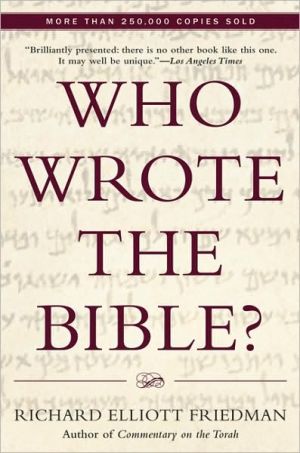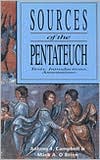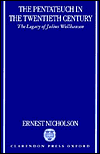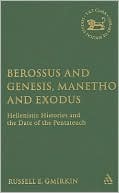Who Wrote the Bible?
"It is a strange fact that we have never known with certainty who produced the book that has played such a central role in our civilization," writes Friedman, a foremost Bible scholar. From this point he begins an investigation and analysis that reads as compellingly as a good detective story. Focusing on the central books of the Old Testament—Genesis, Exodus, Leviticus, Numbers, and Deuteronomy—he draws upon biblical and archaeological evidence to make a convincing argument for the...
Search in google:
"It is a strange fact that we have never known with certainty who produced the book that has played such a central role in our civilization," writes Friedman, a foremost Bible scholar. From this point he begins an investigation and analysis that reads as compellingly as a good detective story. Focusing on the central books of the Old Testament—Genesis, Exodus, Leviticus, Numbers, and Deuteronomy—he draws upon biblical and archaeological evidence to make a convincing argument for the identities of their authors. In the process he paints a vivid picture of the world of the Bible—its politics, history, and personalities. The result is a marvel of scholarship that sheds a new and enriching light on our understanding of the Bible as literature, history, and sacred text. Library Journal Friedman carefully sifts through clues available in the text of the Hebrew Bible and those provided by biblical archaeology searching for the writer(s) of, primarily, the Pentateuch. He does so with clarity and engaging style, turning a potentially dry scholarly inquiry into a lively detective story. The reader is guided through the historical circumstances that occasioned the writing of the sources underlying the Five Books of Moses and the combining of these diverse sources into the final literary product. According to Friedman, the most controversial part of his case is the identification of the writer and date of the Priestly source. This book is neither comprehensive nor unduly complex, making it a good introductory text for beginners and nonspecialists. Recommended for all academic libraries. Craig W. Beard, Harding Univ. Lib., Searcy, Ark.
Chapter One\ \ The World That Produced the Bible: 1200-722 B.C.\ \ \ The Setting\ \ \ The land in which the Bible was born was about the size of a large North American county. It was located along the eastern coast of the Mediterranean Sea, a natural meeting point of Africa, Asia, and Europe.. It had a fabulous variety of climate, flora and fauna, and topographic characteristics. In the northeast was a beautiful freshwater lake, the Sea of Galilee. It flowed into the Jordan River to the south. The river flowed in a straight line south and emptied into the Dead Sea, which was as unlike the Galilee as two bodies of water can possibly be. It was thick with salt. It was surrounded by hot wilderness. According to the traditions of that region the Dead Sea area had once been a pleasant, fertile place, but the people who lived there were so corrupt that God rained brimstone and fire on the place until it was left hardly fit for occupation.\ The northern part of the country was fertile, with plains, small hills and valleys. The center of the country had beaches and lowlands along the Mediterranean coast on the west, and hills and mountains on the east. The southern part of the country was largely desert. It was hot and humid along the coast, especially in summer. It was drier in the hills, still drier in the desert. It was cold enough to snow occasionally on the hills in winter. It was beautiful. The people could see the beauty of the sea, the beauty of lake, flowers, and fields, and the beauty of desert all within a few miles of each other.\ As striking as the variety of the land itself was the variety ofits people. The Bible refers to peoples from numerous backgrounds who mixed there: Canaanites, Hittites, Amorites, Perizzites, Hivites, Girgashites, Jebusites. There were also the Philistines, who stood out as different from the others, apparently having come across the Mediterranean from the Greek islands. There was also a circle of people around the borders of the land. To the north were the Phoenicians, who are usually credited with having introduced writing in that region. Along the eastern borders were Syria in the north, then Ammon, then Moab, then Edom to the south. Then of course there were the Israelites, the most numerous people within the boundaries of the land from the twelfth century B.C. on, the people about whom most of the biblical stories are told. The land lay along the route of travel between Africa and Asia, and so there were the influences--and interests--of Egypt and Mesopotamia in the region as well.\ The population was both urban and rural; it is difficult to say in what proportion. Certainly the percentage of city residents was large. There were times of considerable economic prosperity and times of hardship. There were times of great political strength and influence, and there were periods of domination by foreign powers. And, of course, there were times of peace and times of war.\ The dominant religion across the ancient Near East was pagan religion. Pagan religion was not idol worship, as formerly it was thought to be. The archeological revolution of the past hundred years has opened up that world to us and given us, among other revelations, a new understanding and appreciation of the pagan religious worldview. At Nineveh alone-the greatest archeological discovery of all time-were found fifty thousand tablets, the library of the emperor of Assyria. At the Canaanite city of Ugarit, three thousand more tablets were found. We can read the pagan hymns, prayers, and myths; we can see the places where they worshiped; and we can see how they depicted their gods in art.\ Pagan religion was close to nature. People worshiped the most powerful forces in the universe: the sky, the storm wind, the sun, the sea, fertility, death. The statues that they erected were like the icons in a church. The statues depicted the god or goddess, reminded the worshiper of the deity's presence, showed the humans' respect for their gods, and perhaps made the humans feel closer to their gods. But, as a Babylonian text points out, the statue was not the god.\ The chief pagan god in the region that was to become Israel was El. El was male, patriarchal, a ruler. Unlike the other major god of the region, Haddu (the storm wind), El was not identified with any particular force in nature. He sat at the head of the council of the gods and pronounced the council's decisions.The God of Israel was Yahweh. He, too, was male, patriarchal, a ruler, and not identified with any one force in nature. Rather than describing him in terms of nature or myths, the people of Israel spoke of Yahweh in terms of his acts in history-as we shall see.\ The people of Israel spoke Hebrew. Other languages of the area were similar to Hebrew: Phoenician, Canaanite (Ugaritic), Aramaic, and Moabite are all in the Semitic family of languages. Hebrew and these other languages each had an alphabet. People wrote documents on papyrus and sealed them with stamps pressed in wet clay. They also wrote texts on leather and on clay tablets and occa sionaliy carved them in stone or wrote them on plaster. They wrote shorter notes on pieces of broken pottery.\ People lived in one- and two-story homes, mostly of stone. in cities the houses were built close together. Some of the cities had impressive water systems, including long underground tunnels and huge cisterns. Some houses had indoor plumbing. Cities were surrounded by walls. People ate beef, lamb, fowl, bread, vegetables, fruits, and dairy products. They made wine and beer. They made pots and jars of all sizes out of clay. Their metals were bronze, iron, silver, and gold. They had wind, string, and percussion musical instruments. Contrary to every Bible movie ever made, they did not wear kaffiyehs (Arab headdress).\ There are traditions about the prehistory of the Israelites: their patriarchs, their experiences as slaves in Egypt, and their wandering in the Sinai wilderness. Unfortunately, we have little historical information about this from archeology or other ancient sources. The first point at which we actually have sufficient evidence to begin to picture 0-P life of the biblical community is the twelfth century B.C., the period when the Israelites became established in this region.
\ Library JournalFriedman carefully sifts through clues available in the text of the Hebrew Bible and those provided by biblical archaeology searching for the writer(s) of, primarily, the Pentateuch. He does so with clarity and engaging style, turning a potentially dry scholarly inquiry into a lively detective story. The reader is guided through the historical circumstances that occasioned the writing of the sources underlying the Five Books of Moses and the combining of these diverse sources into the final literary product. According to Friedman, the most controversial part of his case is the identification of the writer and date of the Priestly source. This book is neither comprehensive nor unduly complex, making it a good introductory text for beginners and nonspecialists. Recommended for all academic libraries. Craig W. Beard, Harding Univ. Lib., Searcy, Ark.\ \



